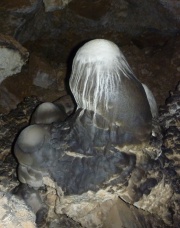Calcite (Inventory)/Stalagmite
From LagWiki
| (5 intermediate revisions not shown) | |||
| Line 1: | Line 1: | ||
| - | The '''Stalagmite''' field of the [[Calcite (Inventory)|Calcite]] section should list stations where calcite stalagmites are observed. [[Gypsum (Inventory)/Stalagmite|Gypsum stalagmites]] have their own | + | {{Inventory image|File:Stalagmite.jpg|Stalagmites}} |
| + | The '''Stalagmite''' field of the [[Calcite (Inventory)|Calcite]] section should list stations where calcite stalagmites are observed. [[Gypsum (Inventory)/Stalagmite|Gypsum stalagmites]] and [[Aragonite (Inventory)/Stalagmite|aragonite stalagmites]] have their own fields on the form. | ||
| - | Stalagmites are [[Floor (Inventory)/Secondary Deposits|secondary floor deposits]] usually of calcite. They are one of the most commonly encountered formations and exhibit as pillars built up by water dripping from the ceiling. The drip source often exhibits a [[Calcite (Inventory)/Stalactite|stalactite]] but not always. Stalagmites are usually larger in diameter than any corresponding stalactite with rounded tops instead of pointed. Stalagmites can vary greatly in size and shape from small to massive formations; from tall, thin poles to wide, fat mounds and anything in between. Stalagmites can be smooth; [[Calcite (Inventory)/Popcorn|popcorn]] covered; layered like piles of plates; fluted; or covered with various other deposits including [[Calcite (Inventory)/Bell Canopy|bell canopies]]. A stalagmite which has joined with its corresponding | + | Stalagmites are [[Floor (Inventory)/Secondary Deposits|secondary floor deposits]] usually of calcite. They are one of the most commonly encountered formations and exhibit as pillars built up by water dripping from the ceiling. The drip source often exhibits a [[Calcite (Inventory)/Stalactite|stalactite]] but not always. Stalagmites are usually larger in diameter than any corresponding stalactite with rounded tops instead of pointed. Stalagmites can vary greatly in size and shape from small to massive formations; from tall, thin poles to wide, fat mounds and anything in between. Stalagmites can be smooth; [[Calcite (Inventory)/Popcorn|popcorn]] covered; layered like piles of plates; fluted; or covered with various other deposits including [[Calcite (Inventory)/Bell Canopy|bell canopies]]. A stalagmite which has joined with its corresponding stalactite is known as a [[Calcite (Inventory)/Column|column]]. |
A calcite stalagmite of any size or shape should be recorded in this field. | A calcite stalagmite of any size or shape should be recorded in this field. | ||
| Line 8: | Line 9: | ||
*[[Floor (Inventory)/Secondary Deposits|Secondary Deposits]] | *[[Floor (Inventory)/Secondary Deposits|Secondary Deposits]] | ||
*[[Gypsum (Inventory)/Stalagmite|Stalagmite (Gypsum)]] | *[[Gypsum (Inventory)/Stalagmite|Stalagmite (Gypsum)]] | ||
| + | *[[Aragonite (Inventory)/Stalagmite|Stalagmite (Aragonite)]] | ||
*[[Calcite (Inventory)/Stalactite|Stalactite]] | *[[Calcite (Inventory)/Stalactite|Stalactite]] | ||
*[[Calcite (Inventory)/Column|Column]] | *[[Calcite (Inventory)/Column|Column]] | ||
| Line 16: | Line 18: | ||
{{Cave inventory}} | {{Cave inventory}} | ||
| - | |||
| - | |||
Current revision as of 12:39, 17 May 2021
The Stalagmite field of the Calcite section should list stations where calcite stalagmites are observed. Gypsum stalagmites and aragonite stalagmites have their own fields on the form.
Stalagmites are secondary floor deposits usually of calcite. They are one of the most commonly encountered formations and exhibit as pillars built up by water dripping from the ceiling. The drip source often exhibits a stalactite but not always. Stalagmites are usually larger in diameter than any corresponding stalactite with rounded tops instead of pointed. Stalagmites can vary greatly in size and shape from small to massive formations; from tall, thin poles to wide, fat mounds and anything in between. Stalagmites can be smooth; popcorn covered; layered like piles of plates; fluted; or covered with various other deposits including bell canopies. A stalagmite which has joined with its corresponding stalactite is known as a column.
A calcite stalagmite of any size or shape should be recorded in this field.
See also
References
- Hill, Carol; Paolo Forti (1997) Cave Minerals of the World (Second Edition ed.) National Speleological Society pp 108-112 ISBN: 1-879961-07-5

